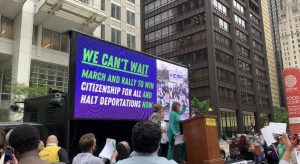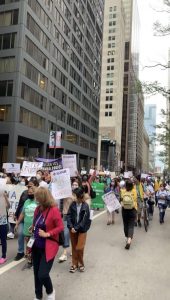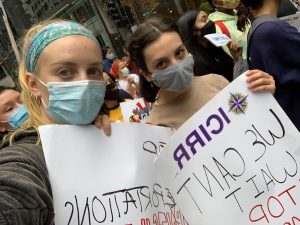Where I come from, the summer months are two things: hot and humid. However, as I stepped outside one July afternoon in Hyde Park, I was surprised to feel neither of these sensations my body has become accustomed to in the Missouri summers. Instead, I felt cold and could feel rain starting to drizzle as me and fellow intern Bianca boarded the 15 bus to the Garfield green line station.
We were headed to a protest and rally in downtown Chicago, hosted by ICIRR, the Illinois Coalition for Immigrant and Refugee Rights. While Bianca seemed rather unphased as we entered the throngs of people that surrounded the Thompson Center on Randolph street once we arrived, I was utterly amazed. I have been to one protest before back in St. Louis, the Women’s March (that also took place all around the country) in January of 2017. At the time, I was only 15 and had a vague understanding of what the protest was for and why it had the potential to be so powerful. However, five years later, I found myself standing in downtown Chicago at another protest, and began to understand, and could even feel, the urgency and energy that surrounded and exuded from those around me.
The official name of the event Bianca and I attended was entitled “March & Rally to Pass Citizenship for ALL, and Stop Deportations NOW”. We felt this would be a fitting event to attend end as we work with women directly affected by the immigration system and are at risk of deportation at essentially any time. The march/rally was much more than just your typical “protest”. ICIRR had a stage setup with a podium and mics that many individuals spoke from, including Illinois Governor JB Pritzker, U.S. Representatives Jan Schakowsky and Marie Newman, several undocumented individuals, and a formerly detained individual Cesar Elizarraraz.
As we walked down Clark street (literally, intersections were blocked off by police as we marched were cars would usually drive), we chanted things such as “say it loud, say it clear, immigrants are welcome here”, “abolish ice”, and “sí se puede” (roughly ‘yes we can’ in Spanish), holding our signs high in the air for passerbyers to see. I’ll admit, we did get some weird looks, but pedestrians also stopped to take photos, even people working in high rise office buildings above us. It felt empowering to be able to “take to the streets” for a change for something that I’m passionate about instead of hiding behind a screen or phone. There is something deeply moving and encouraging about coming together in collective civic engagement to stand up for what is right.
I read a post on Facebook recently that viewed protesting as useless, polarizing, and disrespectful. While protests, marches, and rallies are undoubtedly controversial in more ways than one, they are a way as citizens and residents of the United States that we can say “enough is enough”. The post I’m referring to stated, “while women march the streets of America, protesting for rights that they already have…” . Since reading this, I’ve pondered many times what this uninformed author is saying about our first amendment right to peacefully protest. The reason women and others protest for “rights [we] already have” is because these rights can and are being stripped away from us as we speak. We don’t always protest to gain rights, but rather to protect them, for ourselves and future generations.
Without protest, where would we be today? Would women have won the right to vote? In 1913, the members of the women’s suffrage movement marched on Pennsylvania Avenue in Washington D.C. to gain support and awareness for their cause. Would the Voting Rights Act have passed? In March 1965, Dr. Martin Luther King Jr. and other civil rights activists marched from Selma to Montgomergy passing over the Edmund Pettus Bridge to protect the Black vote. Would Derek Chauvin have been convicted? In June, July, and August of 2020, Black Lives Matter protests happened around the country to demand justice for George Floyd who was murdered by Minneapolis police officer Chauvin after he kneeled on Floyd’s neck for 9 minutes. These occurrences and more are the events that have sparked both controversy and change in the United States. Not only is protest powerful, but it is a right protected by law, and must continue to be protected at all costs.

Some of the signs seen at the rally, reading “ICE – Incompetent, Cowardly, Estupidos” and “We’ve waited a generation, stop deportation”.
In the early days of the Biden administration, his national security team passed new guidelines regarding domestic terrorism. Before January 6th, most Americans were unfamiliar with this term, but since the insurrection, the term has become much more common. As Bianca and I approached the Thompson Center, in addition to the heavy police force that was already present, I noticed two police helicopters above us. I commented to her that they were very loud and made it hard to hear what the speakers on stage were saying. She responded, “well, yeah, technically this could considered domestic terrorism”. I looked at her shocked but tried to listen more closely to what Cesar was saying on stage.
A few days passed, but I kept thinking about what Bianca said about domestic terrorism. As I looked more into the guidelines concerning terrorism, I read about anti-capitalist, anti-state rhetoric and behavior, which the new guidelines consider a form of domestic terrorism. I could see how Bianca connected the lines to our participation in the rally: we were actively protesting a state agency, ICE, and demanding that state-sanctioned deportations be halted for the foreseeable future. Was this domestic terrorism? In the technical sense, maybe it was, but the practical sense, I felt it was simply a peaceful, coordinated protest.
To be completely honest, I’m used to passively fighting injustice. I like to think that people really do read my various Instagram stories concerning topics I care about… but why should they? I have not lost or gained anything by spending 10 seconds merely reposting what hundreds of other people have posted before. I can sit in my comfy bed, and not experience the hot and humid or rainy and cold weather outside my window while doing this work. But when I choose to actively fight injustice, I am up, moving, walking, marching, shutting down streets, taking time out of my work day or my free time, to make a stance. I feel less performative in activism, and instead more engaged, receptive, and willing to learn and do the work I know is crucial.
When lawyer Inez Milholland Boissevain led 5,000 protestors down Pennsylvania Avenue in D.C. for the women’s suffrage march in 1913, she stated “there would be nothing like this happen if you would stay at home”. If we stay at home, hide behind our phones, and are complicit with passive activism, we are doomed to see the causes we care about fall apart. However, if we take the leap of faith to actually go to events and protests, write to our legislators and representatives, and get in “good trouble” as John Lewis put it, we have the opportunity to truly make an impact.
I feel lucky that my placement site has aligned with and fostered my personal passions, giving me the opportunities and networks to engage in social activism, and I encourage you to find a like-minded person and/or organization that allows you to do the same.
Sources & Extra Reading:
- Hundreds rally in Chicago for an end to detentions and a pathway to citizenship for immigrants – Chicago Tribune (An article that details the ICIRR rally)
- Illinois Coalition for Immigrant and Refugee Rights (icirr.org) (ICIRR website)
- Marching for the Vote: Remembering the Woman Suffrage Parade of 1913 – American Women: Topical Essays – Research Guides at Library of Congress (loc.gov) (Information about the women’s suffrage march/movement)



